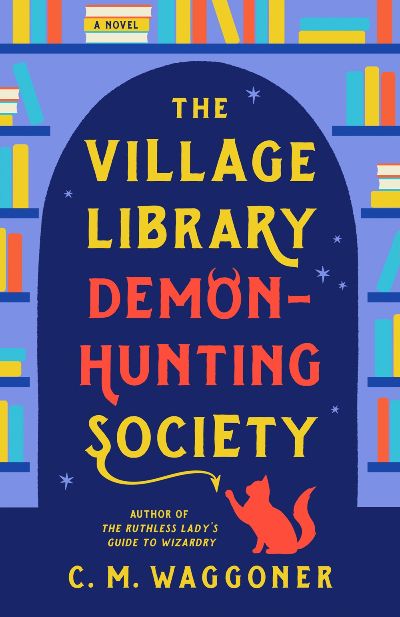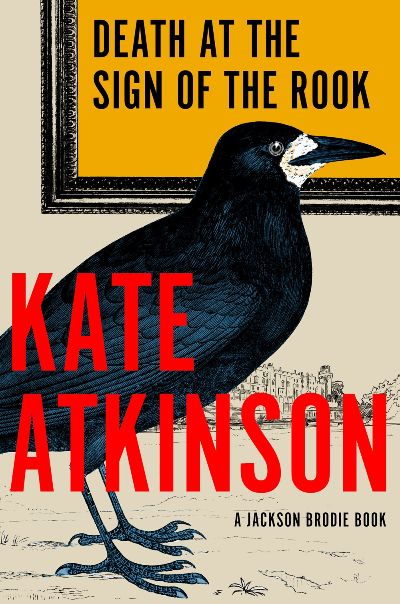The third volume in Rosen’s Evander Mills series is the most powerful to date, going deeper into the community “Andy” Mills has created for himself while taking on the power of secrecy in post-World War II San Francisco. Former cop, currently a PI—without the documentation—Andy is called upon in this book to locate Howard Salzberger, a queer bookseller who has a little brown book that documents all of his customers, and who has loose ties to Andy. Howard has a book he is planning to sell—perhaps about the Mafia?—when he suddenly disappears. While this is historical fiction, set in the ’50s, readers of Rough Pages will surely reflect on the harassment and persecution of librarians, teachers, and students who seek or make available LGBTQ content in present-day America.
Mystery & Detective
Benedict’s many fans know that her Christmas mysteries (The Christmas Murder Game and Murder on the Christmas Express, both 2022) offer layers: they’re great cozy-adjacent mysteries (a bit more violent than many cozies) that involve word and jigsaw puzzles, and they include puzzles that the reader can solve along the way (or not; the stories are complete without the “side” activities). In this title, Benedict tells readers to look for the titles of Fleetwood Mac songs sprinkled throughout the text (in honor of bandmember Christine McVie’s 2002 death). Despite its lovable-grump protagonist, Edie O’Sullivan, being a “Christmisanthropist,” the author has also tucked anagrams of Dickens’ novels and Christmas stories into her family tale. The family is crossword setter and jigsaw enthusiast Edie’s—her current family, police-officer great-nephew, Sean, and his husband, who throughout the book are interviewing to be adoptive parents; Edie’s former partner, Sky, around whom she has great regrets; and family from the past, whose loss has paralyzed Edie’s Christmas spirit ever since. This year, she’s forced out of her Scrooge zone when six jigsaw puzzle pieces are delivered to her home with a warning that “Four, maybe more, people will be dead by midnight on Christmas Eve, unless you can put all the pieces together and stop me.” Our heroine is on her toes as killings and more pieces ensue, as is Benedict’s clever plotting and her writing’s emotional heft. A great story for any time of year.
South Cove, the number one tourist trap on the Pacific Coast Highway, becomes a haven again for mystery and intrigue. Jill learns that the venue where she and her police detective boyfriend, Greg, will get married, is unavailable, and she begins to sweat. Another wedding between local antique dealer Josh and his younger girlfriend, Mandy, goes awry when she vanishes without a trace. Was she kidnapped, or did she bail on the wedding and run away, like most of the locals think? An old journal that Josh discovers proves problematic when a professor he was conferring with dies under mysterious circumstances that appear to be related to the journal, which just might contain a treasure map. Jill wants to solve both the disappearance of Mandy and who killed the professor, but she’ll have to do it behind her fiancé’s back. Cahoon juggles a lot of details, but it all works with her charming town and compelling characters. The multi-layered mysteries keep the reader both guessing and turning the pages. Even 16 books in, the series still seems fresh and engaging. Whether your first visit to South Cove or your 16th, it’s a town where you will want to stay for a while.
Take a bit of Buffy, throw in some of Murder, She Wrote, let a very officious cat, Lord Thomas Cromwell, channel an ancient demon—that bit is a trifle frightening—set it all in rural New York state under the auspices of local librarian Sherry Pinkwhistle, and you have a novel both fun-loving and poignant. Sherry realizes that something is a bit off in Winesnap, NY. Namely, people are regularly being killed, and she typically ends up helping the cops track down the murderer. But when a friend’s husband is found dead, Sherry ups her game, assembling a small group, the Demon Hunting Society, including the new town priest (good for exorcism!). No interest in the supernatural? Don’t be silly. This book has a big enough reach to appeal to any cozy reader, with Sherry delivering a riveting denouement in the manner of Dame Agatha.
The five novels featuring former police officer Jackson Brodie—this would be the sixth—are each a bit idiosyncratic. But Atkinson’s many fans need to brace themselves for this title, a delightful, cozyish homage to the Golden Age of Detective Fiction. We start out at a Murder Mystery Weekend in Rook Hall, “a country house hotel located within Burton Makepeace House, one of England’s premier stately homes.” Dowager Marchioness Lady Milton and her hateful offspring have already auctioned off most of the artwork, commercialized what they could, and sold the remaining cottages. Back to Jackson, hired by a brother and sister to track down their mother’s carer, who disappeared with a Renaissance portrait—artist and provenance unknown—shortly after their mother died. There are some extraordinary similarities, not in the art itself, but between how the Renaissance work, and a Turner painting that went missing from Burton Makepease House several years back, were stolen. Which is how Jackson ends up at the Mystery Weekend. This book dazzles in three ways. One, the interior monologues—Atkins goes deep into the lives of many of the characters—are just brilliant. Two, the dialogue is terrifically clever, with the aristocrats in particular pulling no punches. Three, the gathering for Mystery Weekend brings together all manner of participants, from the vicar to a California cardiologist to an army major to a couple of corpses, in an evening that turns out to be as dark as it is comic. And did I mention the snowstorm that traps them all in Burton Makepeace House?
Marr’s thrillers have a knack for getting inside the minds and lives of modern women, and this one continues that run, here in the high-flying (and sometimes just high) world of celebrity PR. Addison Stern is a bitchy, ruthless PR star to the stars. She’ll do anything for her clients, including ruining junior media employees who might be naive enough to try to look beneath the surface of the stars’ fake tans and Botox. She’s vying for a partnership at her firm, and finding her pharma-bro client, Phinneas Redwood, dead is not what she needs, especially when that murder is followed by other crimes that all lead investigators to Addison. She never thought she’d see the day, but she partners with her private-detective ex, Connor Windell—he’s only too happy to leave a losing streak in Las Vegas—to get to the bottom of things and save herself. The two are off on a jet-setting investigation that takes them to Monaco and other more-money-than-sense places in search of the truth. The touch of Jackie Collins here–the ridiculous riches if not the steaminess—adds a deliciously over-the-top touch to a fast-moving, satisfying whodunit.
A wonderfully rich narrative that ricochets between the past and the present, reminding us just how complex life can be. Madeline Brimley left rural Georgia years ago, eventually settling in Atlanta to pursue a career in the theater, a career that’s now floundering. Then she learns that her beloved Aunt Rose—who has been a role model for Madeline throughout her life—has died, leaving her an eccentric bookstore housed in a grand old Victorian mansion in Enigma, GA. But there’s a catch. According to Rose’s will, Madeline needs to live in Enigma for a year before the store belongs to her. Is this the life Madeline wants? Add to this several acts of violence directed against her—menacing phone calls, a threatening fire, and a startling murder—and Madeline, and the reader, are questioning the many secrets that are all too alive in this tiny town. Fortunately, Madeline is befriended by several women—the Episcopalian reverend in particular—who bring plenty of joy and laughter to the story. And while this novel would seem to use many of the classic cozy tropes, it is wonderfully unique in its own right. Looking forward to more of Madeline.
Before heading to her evening shift as an investigator for Phoenix Seven, an Italian liaison unit that works with the U.S. military in Naples, Nikki Serafino is relaxing on the sailboat she co-owns with her friend, undercover cop Valerio Alfieri, when they rescue a woman who has been abandoned in the bay by her abusive boyfriend. As they head back to port, the Calypso’s keel strikes a decomposing body; Nikki notes the ligature marks on the man’s neck. The next day, while assisting a U.S. serviceman and his family in the wake of a traffic accident, she discovers another murder victim, this time one who’s been shot to death. After the bodies are identified as American naval officers, Nikki must conduct a tricky balancing act of partnering with both NCIS Special Agent Durant Cole and the Italian police in the investigation of possible links between the killings. Could the Camorra Mafia be involved? At the same time, Nikki’s intense family drama, involving the recent loss of her American mother, a loser brother in deep debt to local gangsters, and a tumultuous relationship with her controlling boyfriend, Enzo, threaten to derail her probe. Heider, who lived in Naples for several years and deployed as a civilian analyst aboard U.S. and European naval ships, makes an impressive debut with this engrossing thriller that captures both the baroque beauty and gritty danger of Italy’s third-largest city. It also introduces a tattooed, kick-ass female protagonist (“Nikki was short and compact and muscular with a dynamic, interesting face”) who may remind some readers of Stieg Larsson’s Lisbeth Salander but without that character’s severe asocial tendencies. If there is a minor flaw, it’s that the Heider’s vividly drawn Italian characters far outshine her dull American counterparts. An enjoyable summer read.
Hang on to your hats, this is quite the ride. Three writers—Kat De Noir (writer of erotica), Cassie Pringle (a Southern mom and writer of multiple cozies), and Emma Endicott (uptight New England author of historical fiction)—meet up at Bouchercon, the leading crime writers’ conference. The three women have lots in common: same editor and same obsession with the leading literary hot shot, Brett Saffron Presley (BSP). BSP is currently living on a remote island off the Hebrides, basically as a recluse, and the three women head off to the island to work on their joint novel. Or is that really their intent? Turns out that they each know BSP, and loathe him equally—for pretty much the same reasons—and BSP-stalking takes precedence over any writing. Castle Kinloch, an over-the-top Gothic castle full of hidden passages, provides the background, while the sordid history of a 19th-century laird lends a contemporary creepiness. Enjoy plenty of humor among the women and the native Scots, lots of insider jokes about the publishing industry, and a great big helping of Scottish Romance. Williams, Willig, and White have delivered one fabulous ride that’s sure to leave readers hungry for more.
Michael Falco’s novels are a bit like War and Peace, if Tolstoy wrote cozies set on the Amalfi coast. They are big and sprawling, as rich with characters—most family, many returnees—as they are rich in plot. But at the center of the book stands Bria Bartolucci, the young widow and mother who moved to Positano to open a B&B, now a great success. But bad things still happen, and when a famous chef is murdered—poisoned!—while filming a cooking show, it’s Bria who is right next to him. From there we are off and running as Bria attempts to solve who murdered the chef—an endeavor that is wrapped up in a series of smaller mysteries, likely suspects, and red herrings—without getting killed herself. Come for the mystery, but stay for the wonderful humor and the familial love. Some diversity—doesn’t every family have at least one queer cousin?—would go far in making the series more credible.










